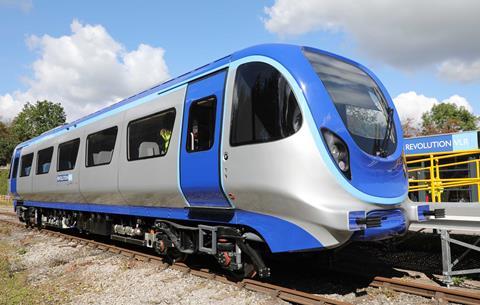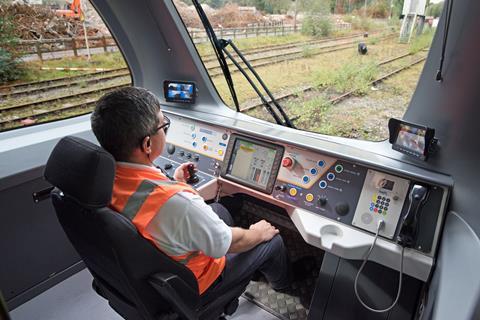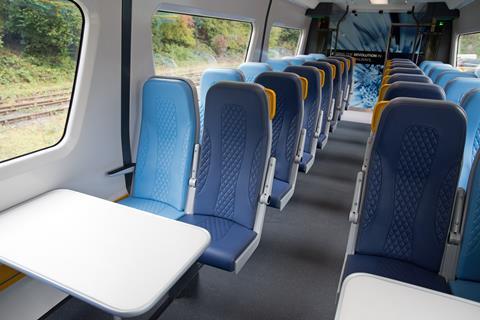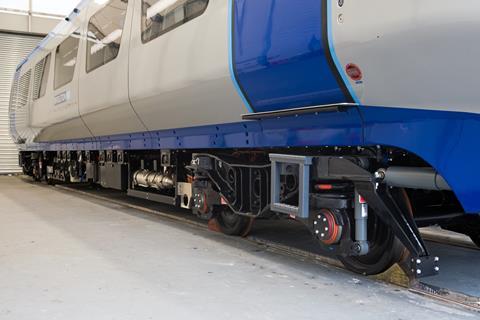Rail Business UK takes a ride on the Revolution Very Light Rail vehicle, which is designed to provide an attractive, low-cost option to facilitate the reopening of disused branch lines and extending existing lines.

UK: Eversholt Rail and Transport Design International have launched their Revolution Very Light Rail demonstrator vehicle, developed as the result of the Radical Train challenge set by the Rail Safety & Standards Board and the Department for Transport. This aimed to provide an attractive, low-cost vehicle that could encourage modal shift to rail by enabling the provision of better services on branch lines and facilitating the reopening of disused lines as well as network extensions.
The RVLR demonstrator is being showcased at a purpose-built marketing facility on the disused railway to the former Ironbridge power station in the West Midlands; this enables stakeholders and potential sponsors to understand the design and experience the vehicle in a representative line reopening scenario.
Design
The RVLR project was launched in 2014 and undertaken by the Revolution VLR Consortium led by Transport Design International and including safety and standards body RSSB, leasing company Eversholt Rail, Warwick Manufacturing Group at the University of Warwick, engine supplier Cummins, Coventry-based autonomous pod manufacturer RDM Group and Transcal.
The consortium says 70% of the components for the demonstrator have come from the UK supply chain. Some of the consortium members are also involved in a separate initiative to develop a prototype lightweight low-floor tram for Coventry.
The RVLR vehicle is 18 m long and has a welded steel chassis and bogies based on a proven freight design from Wabtec, with targeted mass reduction measures including the use of hollow axle Lucchini wheelsets, smaller-diameter wheels and carbon-fibre propshafts.
The lightweight carbon fibre composite body panels are interchangeable and individually replaceable. The cabs and roof are made from aluminium and reinforced composite.

The RVLR demonstrator is powered by two 2·8 litre turbocharged Cummins common rail diesel engines complying with Euro 6 emissions standards for road vehicles; according to the developers, this the first time a Euro 6 engine has been used in a rail application. Each powers a generator which feeds a 30 kWh lithium titanate battery pack and the bogie-mounted drive motors, and is linked to an associated cooler group.
The two engine/generator/battery/motor groups can be operated independently, giving the option to run under reduced power and to ensure the vehicle can continue on its journey or run to a suitable place to allow passengers to disembark safely in the event of a failure.
The batteries support regenerative braking to provide zero emission operation and near-silent running in stations and built-up areas and at speeds up to 30 km/h; the vehicle is capable of speeds up to 105 km/h.
TDI said that the powerpack and battery mix can be adapted to suit specific conditions, with battery-only and hydrogen-powered versions either in development or considered viable for the future.
All parts of the powerpacks are ‘plug and play’ with TDI indicating that one could be changed in a lineside operation in around 20 min Other maintenance operations could also be carried out onboard or at the lineside, removing the need for extensive maintenance facilities.
Passenger environment
The interior features lightweight seats with armrests and tear-resistant E-Leather. The seats have a pitch of 770 mm or greater and optional airline, bay or mixed seating layouts.

The vehicle has air-conditioning, LED lighting and USB charging sockets for personal mobile devices. There is one wheelchair space as standard, and luggage stacks and bicycle storage can be included as required.
‘The modular design of Revolution VLR facilitates the rapid and cost-effective development of different internal layouts to suit customers’ specific needs, together with variants tailored to specific roles, such as a freight version with dedicated loading and offloading doors’, said Darren Smith, head of TDI.
The vehicle is fully bidirectional, with the large driver’s windows offering a good field of view to facilitate line-of-sight operation.
Input into the cab layout from operators has seen the inclusion of switches for frequently used functions alongside the high-definition configurable touchscreen display with menu options. The driver is also provided with a suite of onboard cameras and associated displays.
Future routes
Extensive structural analysis was carried out ahead of construction, with crashworthiness exceeding minimum standards for the sector.
Eversholt and TDI say that this is in line with the proposed use on existing or re-opened branch lines which ‘run into bay platforms’ so shared running with main line vehicles is not a prerequisite. The provision of in-cab signalling and agreements on appropriate safety measures could also allow limited use on main lines if this was required.
Demonstrating the vehicle on a line unused for passenger services since 1963 highlights the potential for abandoned routes to be reinstated quickly and at low cost; Eversholt Rail and TDI worked closely with Harworth Developments over the past six months to develop the Ironbridge demonstration site with the aim of illustrating how rapidly a reopening could be implemented when all stakeholders are aligned and committed.
‘We’re delighted to be working with TDI and Eversholt Rail to bring Revolution VLR to our Ironbridge site, where we are transforming the former Ironbridge Power Station into a mixed-use development of up to 1 000 homes, alongside a range of commercial, leisure and community uses’, said Tim Hurdiss, Associate Director, Major Projects at Harworth Group. ‘Together we are exploring the possibilities of how the former sidings and freight line could be brought back into use, opening up the prospect of passengers one day being able to arrive at Ironbridge by rail.’

As well as operating on existing rail infrastructure, RVLR’s low mass enables it to operate on lightweight modular slab track that is less costly to install and maintain than traditional heavy rail infrastructure.
The demonstrator has a mass of 24·8 tonnes, a saving of nearly 40% compared with a single-car self-powered heavy rail vehicle of similar capacity such as the Class 153 DMU, whilst providing 54 seats and a wheelchair space.
‘We believe that RVLR’s characteristics and cost-effectiveness will really assist the business cases for rail line reopenings and extensions across the UK’, said Paul Sutherland, Client Services Director at Eversholt Rail.



